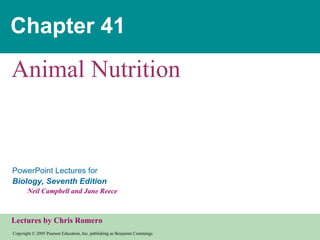
41 animalnutrition text
- 1. Chapter 41 Animal Nutrition
- 43. Figure 41.15 IIeum of small intestine Duodenum of small intestine Appendix Cecum Ascending portion of large intestine Anus Small intestine Large intestine Rectum Liver Gall- bladder Tongue Oral cavity Pharynx Esophagus Stomach Pyloric sphincter Cardiac orifice Mouth Esophagus Salivary glands Stomach Liver Pancreas Gall- bladder Large intestines Small intestines Rectum Anus Parotid gland Sublingual gland Submandibular gland Salivary glands A schematic diagram of the human digestive system Pancreas
- 70. Chapter 42 Circulation and Gas Exchange
- 165. Figure 42.27 Inhaled air Exhaled air 160 0.2 O 2 CO 2 O 2 CO 2 O 2 CO 2 O 2 CO 2 O 2 CO 2 O 2 CO 2 O 2 CO 2 O 2 CO 2 40 45 40 45 100 40 104 40 104 40 120 27 CO 2 O 2 Alveolar epithelial cells Pulmonary arteries Blood entering alveolar capillaries Blood leaving tissue capillaries Blood entering tissue capillaries Blood leaving alveolar capillaries CO 2 O 2 Tissue capillaries Heart Alveolar capillaries of lung <40 >45 Tissue cells Pulmonary veins Systemic arteries Systemic veins O 2 CO 2 O 2 CO 2 Alveolar spaces 1 2 4 3
- 171. O 2 unloaded from hemoglobin during normal metabolism O 2 reserve that can be unloaded from hemoglobin to tissues with high metabolism Tissues during exercise Tissues at rest 100 80 60 40 20 0 100 80 60 40 20 0 100 80 60 40 20 0 100 80 60 40 20 0 Lungs P O 2 (mm Hg) P O 2 (mm Hg) O 2 saturation of hemoglobin (%) O 2 saturation of hemoglobin (%) Bohr shift: Additional O 2 released from hemoglobin at lower pH (higher CO 2 concentration) pH 7.4 pH 7.2 (a) P O 2 and Hemoglobin Dissociation at 37°C and pH 7.4 (b) pH and Hemoglobin Dissociation Figure 42.29a, b
- 174. Figure 42.30 Tissue cell CO 2 Interstitial fluid CO 2 produced CO 2 transport from tissues CO 2 CO 2 Blood plasma within capillary Capillary wall H 2 O Red blood cell Hb Carbonic acid H 2 CO 3 HCO 3 – H + + Bicarbonate HCO 3 – Hemoglobin picks up CO 2 and H + HCO 3 – HCO 3 – H + + H 2 CO 3 Hb Hemoglobin releases CO 2 and H + CO 2 transport to lungs H 2 O CO 2 CO 2 CO 2 CO 2 Alveolar space in lung 2 1 3 4 5 6 7 8 9 10 11 To lungs Carbon dioxide produced by body tissues diffuses into the interstitial fluid and the plasma. Over 90% of the CO 2 diffuses into red blood cells, leaving only 7% in the plasma as dissolved CO 2 . Some CO 2 is picked up and transported by hemoglobin. However, most CO 2 reacts with water in red blood cells, forming carbonic acid (H 2 CO 3 ), a reaction catalyzed by carbonic anhydrase contained. Within red blood cells. Carbonic acid dissociates into a biocarbonate ion (HCO 3 – ) and a hydrogen ion (H + ). Hemoglobin binds most of the H + from H 2 CO 3 preventing the H + from acidifying the blood and thus preventing the Bohr shift. CO 2 diffuses into the alveolar space, from which it is expelled during exhalation. The reduction of CO 2 concentration in the plasma drives the breakdown of H 2 CO 3 Into CO 2 and water in the red blood cells (see step 9), a reversal of the reaction that occurs in the tissues (see step 4). Most of the HCO 3 – diffuse into the plasma where it is carried in the bloodstream to the lungs. In the HCO 3 – diffuse from the plasma red blood cells, combining with H + released from hemoglobin and forming H 2 CO 3 . Carbonic acid is converted back into CO 2 and water. CO 2 formed from H 2 CO 3 is unloaded from hemoglobin and diffuses into the interstitial fluid. 1 2 3 4 5 6 7 8 9 10 11
- 178. Chapter 43 The Immune System
- 225. 2 1 3 B cell Bacterium Peptide antigen Class II MHC molecule TCR Helper T cell CD4 Activated helper T cell Clone of memory B cells Cytokines Clone of plasma cells Secreted antibody molecules Endoplasmic reticulum of plasma cell Macrophage After a macrophage engulfs and degrades a bacterium, it displays a peptide antigen complexed with a class II MHC molecule. A helper T cell that recognizes the displayed complex is activated with the aid of cytokines secreted from the macrophage, forming a clone of activated helper T cells (not shown). 1 A B cell that has taken up and degraded the same bacterium displays class II MHC–peptide antigen complexes. An activated helper T cell bearing receptors specific for the displayed antigen binds to the B cell. This interaction, with the aid of cytokines from the T cell, activates the B cell. 2 The activated B cell proliferates and differentiates into memory B cells and antibody-secreting plasma cells. The secreted antibodies are specific for the same bacterial antigen that initiated the response. 3 Figure 43.17